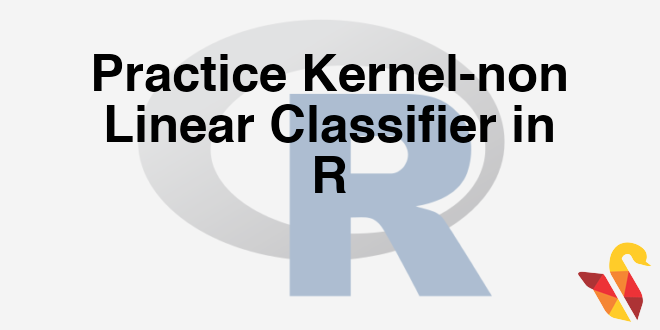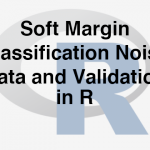
In previous section, we studied about The Non-Linear Decision Boundary
In this session we will practice non linear kernels of SVM in python.
LAB: Kernel – Non linear classifier
- Dataset : Software users/sw_user_profile.csv
- How many variables are there in software user profile data?
- Plot the active users against and check weather the relation between age and “Active” status is linear or non-linear
- Build an SVM model(model-1), make sure that there is no kernel or the kernel is linear
- For model-1, create the confusion matrix and find out the accuracy
- Create a new variable. By using the polynomial kernel
- Build an SVM model(model-2), with the new data mapped on to higher dimensions. Keep the default kernel in R as linear
- For model-2, create the confusion matrix and find out the accuracy
- Plot the SVM with results.
- With the original data re-cerate the model(model-3) and let R choose the default kernel function.
- What is the accuracy of model-3?
Solution
sw_user_profile <- read.csv("C:\\Amrita\\Datavedi\\Software Users\\sw_user_profile.csv")
head(sw_user_profile)## Id Age Active
## 1 1 9.438867 0
## 2 2 8.614807 0
## 3 3 5.817555 0
## 4 4 10.329219 0
## 5 5 6.527926 0
## 6 6 8.231147 0#How many variables are there in software user profile data?
names(sw_user_profile)## [1] "Id" "Age" "Active"#Plot the active users against and check weather the relation between age and "Active" status is linear or non-linear
plot(sw_user_profile$Age,sw_user_profile$Id, col=as.integer(sw_user_profile$Active+1))#Build an SVM model(model-1), make sure that there is no kernel or the kernel is linear
library(e1071)
svm_model_nl <- svm(Active~Age, type="C", data=sw_user_profile)
summary(svm_model_nl)##
## Call:
## svm(formula = Active ~ Age, data = sw_user_profile, type = "C")
##
##
## Parameters:
## SVM-Type: C-classification
## SVM-Kernel: radial
## cost: 1
## gamma: 1
##
## Number of Support Vectors: 16
##
## ( 8 8 )
##
##
## Number of Classes: 2
##
## Levels:
## 0 1#Making the kernel to linear
svm_model_nl <- svm(Active~Age, type="C", kernel="linear", data=sw_user_profile)
summary(svm_model_nl)##
## Call:
## svm(formula = Active ~ Age, data = sw_user_profile, type = "C",
## kernel = "linear")
##
##
## Parameters:
## SVM-Type: C-classification
## SVM-Kernel: linear
## cost: 1
## gamma: 1
##
## Number of Support Vectors: 347
##
## ( 174 173 )
##
##
## Number of Classes: 2
##
## Levels:
## 0 1#For model-1, create the confusion matrix and find out the accuracy
library(caret)## Loading required package: latticeAge_predicted<-predict(svm_model_nl)
confusionMatrix(Age_predicted,sw_user_profile$Active)## Confusion Matrix and Statistics
##
## Reference
## Prediction 0 1
## 0 317 173
## 1 0 0
##
## Accuracy : 0.6469
## 95% CI : (0.6028, 0.6893)
## No Information Rate : 0.6469
## P-Value [Acc > NIR] : 0.5207
##
## Kappa : 0
## Mcnemar's Test P-Value : <2e-16
##
## Sensitivity : 1.0000
## Specificity : 0.0000
## Pos Pred Value : 0.6469
## Neg Pred Value : NaN
## Prevalence : 0.6469
## Detection Rate : 0.6469
## Detection Prevalence : 1.0000
## Balanced Accuracy : 0.5000
##
## 'Positive' Class : 0
## #Create a new variable. By using the polynomial kernel
###Standardizing the data to visualize the results clearly
sw_user_profile$age_nor<-(sw_user_profile$Age-mean(sw_user_profile$Age))/sd(sw_user_profile$Age)
plot(sw_user_profile$age_nor,sw_user_profile$Id, col=as.integer(sw_user_profile$Active+1))#Creating the new variable
sw_user_profile$new<-(sw_user_profile$age_nor)^2
plot(sw_user_profile$Age,sw_user_profile$new, col=as.integer(sw_user_profile$Active+1))#Build an SVM model(model-2), with the new data mapped on to higher dimensions. Keep the default kernel in R as linear
svm_model_2 <- svm(Active~Age+new, type="C", kernel="linear", data=sw_user_profile)
summary(svm_model_2)##
## Call:
## svm(formula = Active ~ Age + new, data = sw_user_profile, type = "C",
## kernel = "linear")
##
##
## Parameters:
## SVM-Type: C-classification
## SVM-Kernel: linear
## cost: 1
## gamma: 0.5
##
## Number of Support Vectors: 15
##
## ( 8 7 )
##
##
## Number of Classes: 2
##
## Levels:
## 0 1#For model-2, create the confusion matrix and find out the accuracy
library(caret)
Age_predicted<-predict(svm_model_2)
confusionMatrix(Age_predicted,sw_user_profile$Active)## Confusion Matrix and Statistics
##
## Reference
## Prediction 0 1
## 0 317 0
## 1 0 173
##
## Accuracy : 1
## 95% CI : (0.9925, 1)
## No Information Rate : 0.6469
## P-Value [Acc > NIR] : < 2.2e-16
##
## Kappa : 1
## Mcnemar's Test P-Value : NA
##
## Sensitivity : 1.0000
## Specificity : 1.0000
## Pos Pred Value : 1.0000
## Neg Pred Value : 1.0000
## Prevalence : 0.6469
## Detection Rate : 0.6469
## Detection Prevalence : 0.6469
## Balanced Accuracy : 1.0000
##
## 'Positive' Class : 0
## #Plot the SVM with results.
plot(svm_model_2, sw_user_profile,new~Age ) #With the original data re-cerate the model(model-3) and let R choose the default kernel function.
library(e1071)
svm_model_3 <- svm(Active~Age, type="C", data=sw_user_profile)
summary(svm_model_3)##
## Call:
## svm(formula = Active ~ Age, data = sw_user_profile, type = "C")
##
##
## Parameters:
## SVM-Type: C-classification
## SVM-Kernel: radial
## cost: 1
## gamma: 1
##
## Number of Support Vectors: 16
##
## ( 8 8 )
##
##
## Number of Classes: 2
##
## Levels:
## 0 1#What is the accuracy of model-3?
library(caret)
Age_predicted<-predict(svm_model_3)
confusionMatrix(Age_predicted,sw_user_profile$Active)## Confusion Matrix and Statistics
##
## Reference
## Prediction 0 1
## 0 317 0
## 1 0 173
##
## Accuracy : 1
## 95% CI : (0.9925, 1)
## No Information Rate : 0.6469
## P-Value [Acc > NIR] : < 2.2e-16
##
## Kappa : 1
## Mcnemar's Test P-Value : NA
##
## Sensitivity : 1.0000
## Specificity : 1.0000
## Pos Pred Value : 1.0000
## Neg Pred Value : 1.0000
## Prevalence : 0.6469
## Detection Rate : 0.6469
## Detection Prevalence : 0.6469
## Balanced Accuracy : 1.0000
##
## 'Positive' Class : 0- The next post is about Soft Margin Classification Noisy Data and Validation.




